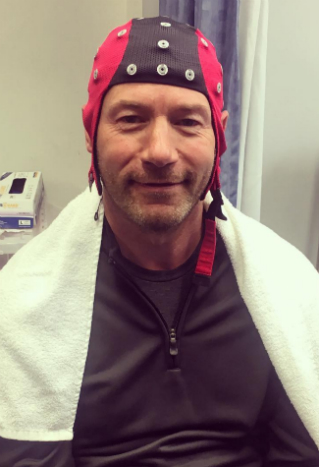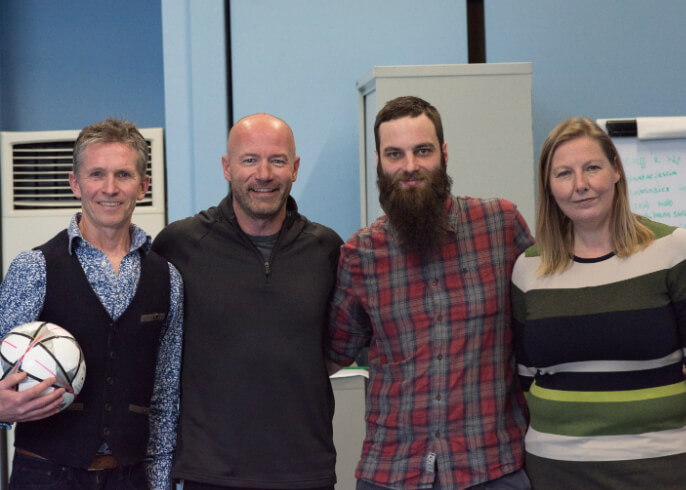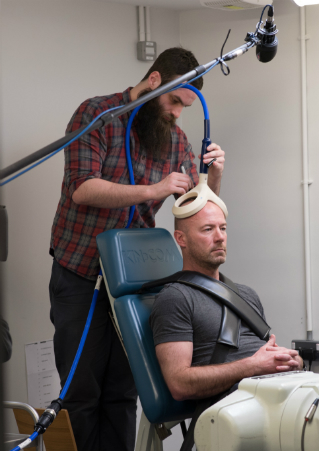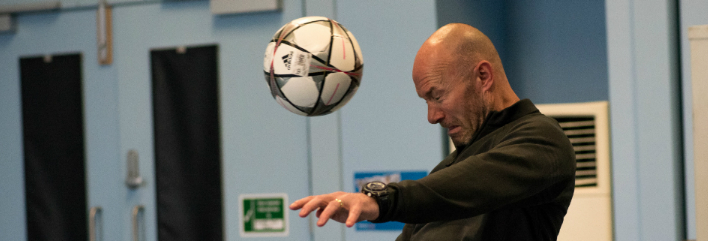University of Stirling experts who led a landmark study into the risks posed by heading footballs say more scientific research is urgently required.

To understand the risks posed by heading, a range of novel neuroscience techniques need to be developed, according to those leading Stirling’s research.
The calls from cognitive neuroscientist Dr Magdalena Ietswaart and Dr Angus Hunter, Reader in Exercise Physiology, follows a BBC One investigation by former England international Alan Shearer.
‘Alan Shearer: Dementia, Football and Me’ heard from current and retired professional footballers, the relatives of former players diagnosed with dementia, the Football Association (FA), the Professional Footballers’ Association (PFA) and scientists in sports medicine. Many of those interviewed raised concerns that there could be a link between heading the ball and brain health but said that more research is required.
The documentary included footage of Shearer undergoing tests in a lab at Stirling, where academics have, for the first time, found direct evidence of brain changes immediately after heading a ball.

Alan Shearer (second left) pictured with Stirling’s (L-R) Dr Angus Hunter, Tom Di Virgilio and Magdalena Ietswaart.
The FA and PFA have commissioned research into whether the degenerative neurocognitive disease is more common in ex-professional footballers than the rest of the population.
However, while Dr Ietswaart and Dr Hunter welcomed this research, they believe funding is required for scientific studies that would provide understanding of the risks associated with heading footballs.
Dr Ietswaart said: “We do not yet know whether there is a definitive link between football and dementia. This can only be discovered by carrying out research in this area.

Alan Shearer's brain function was measured before and after heading the ball 20 times.
“Scientific developments open up a new approach that is achievable but requires a robust funding drive. If you want real answers, you need to understand what is happening in the brain; what is cause and effect, the approach we use here at Stirling.
“Until now, we did not have sensitive or direct ways to identify how moving a ball with your head can impact brain health. However, we now have stronger neuroscience emerging that can look directly at what goes on in the brain as a result of heading the ball. We have applied these techniques here at Stirling but there is a lot more that we and others can do to give definitive answers on the dangers of heading.
“Current neuroscience has substantial promise in providing the evidence-base on the effects playing football has on brain health that is currently lacking.”
As part of his investigation, Shearer visited Stirling and underwent tests that showed immediate brain changes after heading the ball – the same changes observed in participants who took part in the landmark study.
The research, published in EBioMedicine, is the first to show direct evidence for short-term sub-concussive changes in the brain following any sport-related impact.
After meeting with the Stirling team, Shearer said: “Football should be encouraging these universities to do as much research as possible but, like everything else, these universities need funding. There’s enough money around nowadays in football but not enough of it is being given to research.
“It is about time we had more definitive answers.”
Dr Hunter echoed Shearer’s comments and said the findings of the Stirling study should form the basis of more in-depth scientific research.
He added: “As conveyed by the BBC documentary, our study is the first to show changes in brain function after heading the ball.
“Combined with the anecdotal evidence, our research and this documentary should provide the stimulus for further scientific research to be carried out in this area.”
Dr Ietswaart and Dr Hunter were supported in the research by Stirling neuropsychologist Professor Lindsay Wilson and PhD student Tom Di Virgilio, consulting with leading University of Glasgow Medical School Neuropathologist Dr Willie Stewart and a wider multi-disciplinary team.
The research was funded by the National Institute of Health Research.
Background information
Media enquiries to Greg Christison, Communications Officer, on greg.christison@stir.ac.uk

